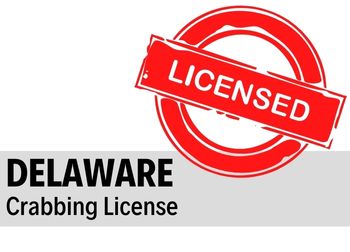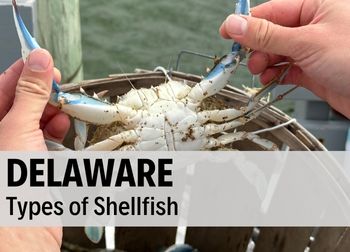Delaware Crabbing Regulations Summarized (Updated for 2021)
State regulations can be complicated and unintelligible, especially for those who are trying to catch a bushel of crabs for a crab feast. Personally, I just want the legal know-how laid out in front of me so I know what I can and cannot do while crabbing in Delaware.
To save you hours of digging through shellfish harvesting code, I did just that! All of the information in this guide comes straight from Title 7 Natural Resources and Environmental Control: 3700 Shellfish. I recommend you read it for more information, or call Delawre’s Department of Fish and Wildlife at 302-739-9910.
Disclaimer: It’s the angler’s responsibility to know and be up to date with his or her state’s fishing and crabbing guidelines. Crabbinghub.com and its writers are not responsible for any failure to follow rules and regulations.
Here are Delaware’s crabbing regulations in three sentences.
In Delaware, crabbing is permitted year-round for all anglers with a recreational fishing license. The only exception to this rule is when you use a crab pot, which is allowed from March 1st to November 30th. You may keep up to one bushel of hardshell blue crabs with a minimum shell width of 5 inches.
There you have it! That’s a summary of Delaware’s crabbing regulations. With this information, you can easily have a successful trip. However, there are a few things that you need to be aware of in order to have a successful crabbing trip. Small details always come up, such as crab trap requirements, licensing information, and so on. I cover all of this and more throughout this article, so be sure to stick around!
Questions & Answers
Do you need a license to go crabbing in Delaware?
In Delaware, you need a recreational fishing license to go crabbing. It costs $8.50 and is required for every fishermen between the age of 16 and 65 years old.
Can you keep female blue crabs in Delaware?
You may keep non-egg bearing mature female blue crabs in the state of Delaware. Her shell width must be no less than 5 inches from point to point. You know the female is mature when her abdomen is a rounded half-circle with a point instead of a sharp “V” shape.
How many crabs can I keep in Delaware?
As a licensed Delaware crabber, you may keep up to one bushel of hardshell blue crabs. One bushel is measured by however many legally-sized blue crabs can fit into a wooden bushel basket with the lid on top.
When is Delaware’s Crabbing Season
Delaware’s crabbing season lasts year-round throughout all of its permitted tidal waterways. The only exception to this rule is when you use a crab pot, which is allowed from March 1st to November 30th.
Where can I go crabbing in Delaware?
Crabbing is permitted in all tidal waterways throughout the state of Delaware unless stated otherwise by the DNREC. Check Delaware’s DNR website for waterway restriction updates.
What traps can I use to go crabbing in Delaware?
Legal Delaware crabbing gear includes:
- No more than two crab pots
- Collapsible Traps (no limit in amount)
- Trotline (no limit in size)
- Handlines (no limit in amount)
- Seine Net (300ft max)
- Handheld dip nets (no limit in amount)
What size crabs can I keep in Delaware?
Delaware Blue Crab Minimum Sizes
| Variation of Blue Crab | Minimum Size |
|---|---|
| Adult hard male crabs (Jimmy) | 5 inches |
| Adult female hard crabs (Sook) | 5 inches |
| Soft crabs | 3.5 inches |
| Peeler crabs | 3 inches |
How To Get a Delaware Crabbing License
As mentioned before, you cannot go crabbing in Delaware without a license. You can apply for and purchase a license online through https://dnrec.alpha.delaware.gov/fish-wildlife/licenses/.
The link above will take you to the general licensing page. This is where people purchase hunting, fishing, and boating licenses. You want to click on Buy a Fishing License.
This will take you to a Digital DNREC sign-in page. You will need to register for an account. It will ask for your personal information, SSN, date of birth, and so on. All of which is important information to validate your fishing license.
If you scroll down on this sign-in page. You will find two user guides with videos. One will walk you through the process of making your account, and the other will do the same with a recreational fishing license.
After creating an account, follow the previously mentioned guide on purchasing a license. Pick the $8.50 option, which will fit all the requirements to go crabbing. You will receive a FIN number and a fishing license in a PDF format. Bring both of these documents with you when you go crabbing. If you are ever stopped by a DNREC officer, he or she will ask for these papers.
For more information on licensing, check out the Delaware.gov website.
Crab Pot Regulations
Like most states in the Mid Atlantic, crab pots are ostracized by state governments. Because these traps can threaten the population of blue crabs when lost, states crack down on their regulations. Delaware is no exception.
If you have no idea what I’m talking about, let me quickly explain what a crab pot is. A crab pot is a wire mesh cage with bait and several openings to let crabs enter. If you’ve ever watched Deadliest Catch or seen a commercial crab boat you know what I’m talking about. The openings are built in a way that allows crabs to enter the trap but prevent them from escaping. For more information, check out my article: How Crab Pots Work (With Pictures!).
With these handy crab traps comes some rules. Here they are:
It is illegal to use more than two crab pots in the state of Delaware.
If you plan on going crabbing with crab pots, each licensed individual can use 2 crab pots. Any more will evidently lead to a fine from a DNR officer. Don’t worry, two pots will do just fine at catching a bushel of crabs. You can also use as many hand lines and collapsible traps as you want to help.
You must collect the crabs from your crab pot once every 72 hours.
To prevent any crabs from starving in their crab pots, you must collect crabs from your pot at least once every 72 hours.
It is illegal to set or use any crab pots between December 1st and the last day in February.
While it is legal to go crabbing with other methods (collapsible traps, trotlines, etc.), you cannot use a crab pot from December 1st to the last day in February. It’s not like you’re missing anything; crabs don’t become active in Delaware until April.
You must install a turtle by-catch device on each entrance of your crab pot.
One unfortunate consequence of crab pots is that they cause the death of turtles. If one of these air-breathing reptiles manage to wiggle themselves into your crab pot, they will eventually drown.
To protect turtle populations, Delaware requires that you have a turtle excluder on the doors of your crab pot. They’re essentially a rectangle frame of wire or plastic measured 1.75 inches tall and 4.75 inches long.
You can pick one up at any local bait and tackle shop or make one yourself. Make sure to pick up some hog rings or zip ties while you’re out. They are needed to secure the turtle excluder to each opening of your trap.
Your crab pot must be attached to an all-white buoy labeled with your full name and permanent mailing address.
It’s a requirement that each crab pot is marked with a white buoy or float. I recommend buying some weighted line and a white float (both of which are available on Amazon) for your pot setup.
You will also need either a waterproof label or some permanent markers to write your name and address on your float. The permanent marker will fade over time, so be sure to rewrite any faded lettering.





